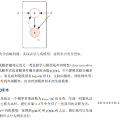Forecasting Parapapillary atrophy (PPA), i.e., a symptom related to most irreversible eye diseases, provides an alarm for implementing an intervention to slow down the disease progression at early stage. A key question for this forecast is: how to fully utilize the historical data (e.g., retinal image) up to the current stage for future disease prediction? In this paper, we provide an answer with a novel framework, namely \textbf{D}isease \textbf{F}orecast via \textbf{P}rogression \textbf{L}earning (\textbf{DFPL}), which exploits the irreversibility prior (i.e., cannot be reversed once diagnosed). Specifically, based on this prior, we decompose two factors that contribute to the prediction of the future disease: i) the current disease label given the data (retinal image, clinical attributes) at present and ii) the future disease label given the progression of the retinal images that from the current to the future. To model these two factors, we introduce the current and progression predictors in DFPL, respectively. In order to account for the degree of progression of the disease, we propose a temporal generative model to accurately generate the future image and compare it with the current one to get a residual image. The generative model is implemented by a recurrent neural network, in order to exploit the dependency of the historical data. To verify our approach, we apply it to a PPA in-house dataset and it yields a significant improvement (\textit{e.g.}, \textbf{4.48\%} of accuracy; \textbf{3.45\%} of AUC) over others. Besides, our generative model can accurately localize the disease-related regions.
翻译:预测 { parapagliary 萎缩 (PPA), 即 与最不可逆转的眼病有关的症状, 为实施干预以减缓疾病早期的发病速度提供了警示。 这一预测的一个关键问题是: 如何充分利用历史数据( 例如视网膜图像) 直至当前阶段, 用于未来疾病预测? 在本文中, 我们给出了答案, 新的框架, 即\ textbf{ Diserise\ textbf{ F} fr} frtbf}, 是一个与最不可逆转的眼病有关的症状, 为实施早期的疾病发病速度提供了警示。 在两个模型中, 我们将当前和不断变异的机型数据应用到当前变异的机型数据 。 在两个模型中, 我们将当前和不断变异的机的机型数据, 我们将当前和不断变异的机变的机能数据, 放到一个机变机变机变机变机变的机变机变机变机。




